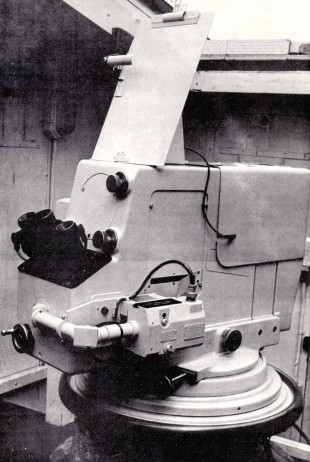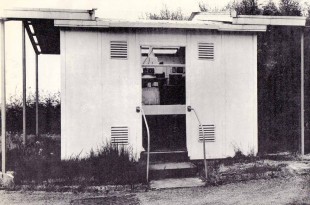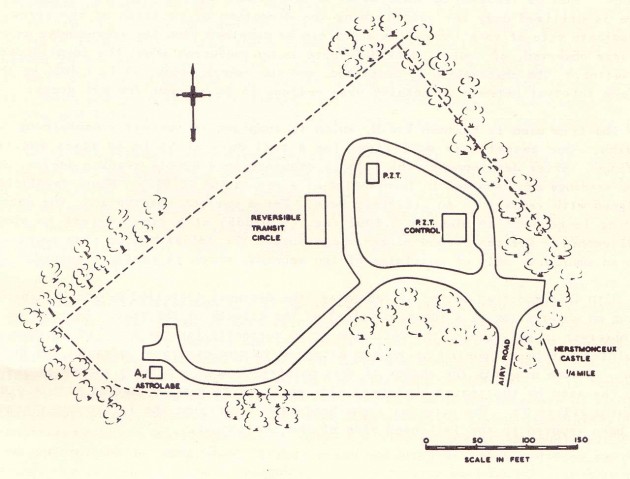…where east meets west
- Home
- Brief History
- The Greenwich Meridian
- Greenwich
(1675–1958) - Herstmonceux
(1948–1990) - Cambridge
(1990–1998) - Outstations (1822–1971)…
- – Chingford (1822–1924)
- – Deal
(1864–1927) - – Abinger
(1923–1957) - – Bristol & Bradford on Avon
(1939–1948) - – Bath
(1939–1949) - – Hartland
(1955–1967) - – Cape of Good Hope
(1959–1971)
- Administration…
- – Funding
- – Governance
- – Inventories
- – Pay
- – Regulations
- – Royal Warrants
- Contemporary Accounts
- People
- Publications
- Science
- Technology
- Telescopes
- Chronometers
- Clocks & Time
- Board of Longitude
- Libraries & Archives
- Visit
- Search
Telescope: 4-inch Danjon Prismatic Astrolabe OPL. No. 9 (1956)

The Danjon Astrolabe as modified at Herstmonceux. Photograph by N.S.C. Rhodes. Reproduced from Royal Observatory Bulletins Number 92
Danjon Astrolabe OPL. No. 9 was brought into service at the Royal Greenwich Observatory, Herstmonceux in July 1959 primarily to extend the study of its effectiveness in determining catalogue corrections. A regular observing programme was commenced in October 1959 and continued until September 1963, when the instrument was withdrawn from service for overhaul prior to its removal to the Royal Observatory, Cape of Good Hope. Between July 1962 and 1963, the instrument provided data for the Greenwich Time and Latitude Service while the Photographic Zenith Tube (PZT) was out of service for investigation and overhaul.
Manufacturer
The Royal Observatory’s Astrolabe was one of more than 20 made between 1956 and 1964 by the French manufacturer Optique et précision de Levallois (OPL) who had been making optical devices since 1919.
Instrumental basics
The Prismatic Astrolabe was originally invented by Auguste Claude in around 1900 and modified in collaboration with Ludovic Driencourt in 1910.
Claude and Driencourt’s instrument consisted of a horizontal telescope for measuring the instant at which a star reached a specific altitude in the sky. It contained an equilateral (60º) prism mounted immediately in front of the telescope’s objective lens with and one face vertical and its three parallel edges horizontal. Below the prism a horizontal mirror was formed by a dish of mercury. The star’s image and its reflection in the mercury mirror were reflected internally in the prism before passing though the lens. The two images converged when the star reached a precise altitude of 30º from the zenith (the altitiude being determined by the angle of the prism).
Click here to view an image of a Claude Driencourt Astrolabe.
Observation of the times of passage of several stars with the instrument allowed not only the latitude of the instrument and the error of the observing clock to be determined but also yielded information on the errors in the adopted co-ordinates of the stars.
The results obtained with such astrolabes were extremely sensitive to change of focus and to personal error in the timing of the coincidences. Both these defects were largely overcome by Danjon who modified the design by inserting a Wollaston prism at the focus. To make the Astrolabe more compact, the light path was folded (which is why it lacks the appearance of a typical telescope). Because it was free from personal error, the Danjon Prismatic Astrolabe is sometimes referred to as an Impersonal Astrolabe.
The Astrolabe hut

The Astrolabe Hut from the North. Photograph by N.S.C. Rhodes. Reproduced from Royal Observatory Bulletins Number 92

Early 1960s plan showing the relative location of the instuments in the Spencer Jones Group. Drawn by J.J. Pharoah and reproduced from Royal Observatory Bulletins Number 92
Instrumental details
Details of the instruments design were described (complete with diagram) by Danjon in his 1958 lecture: The contribution of the impersonal astrolabe to fundamental astronomy (Monthly Notices of the Royal Astronomical Society, Vol. 118, p.411).
Modifications were made to the Herstmonceux instrument because of the lack of availability of a pen chronograph to use with it. Devised by GB Wellgate, in collaboration with CA Murray, and carried out in the Observatory workshops, they were described by DV Thomas in Royal Observatory Bulletins Number 92 from which the following paragraph has been adapted:
The graduated micrometer head of the Wollaston prism driving-screw was replaced by a similar transparent head, and the illuminating lamp by a flash tube operated under the control of an electronic programme unit. By means of a bent optical train, the illuminated portion of the micrometer scale, together with the index mark, was imaged on to the focal plane of a modified Shackman 16 mm cine-camera fixed to the side of the instrument (and can be seen in the illustration above). A diaphragm having two pinholes illuminated by lamps was also situated in the focal plane. One lamp flashed every tenth second as a result of a signal from the master clock, providing timing reference marks: the other was switched on when the Wollaston prism was within half a screw revolution of its central position, obviating the need for a revolution counter. The original contacts were removed, and the redundant control buttons and connections used for the control and wiring of lamp and camera circuits.
Published Observations and catalogues
Royal Observatory Bulletins Number 92, Results obtained with a Danjon Astrolabe at Herstmonceux. I. Observations. D.V. Thomas
Royal Observatory Bulletins, Number 160, Results obtained with a Danjon Astrolabe at Herstmonceux. II. Analysis and Discussion: Herstmonceux Astrolabe Catalogue. D.V. Thomas & R.E. Wallis.
Further Reading
L’Astrolabe Impersonnel A. Danjon Modéle O.P.L. L’Observatoire de Paris. Étude des Résultats D’Une Annee D’Observations. Variation de La Latitude. Catalogue D’étoiles. Guinot, B. Bulletin Astronomique, vol. 22, pp.1-71 (1958)
© 2014 – 2025 Graham Dolan
Except where indicated, all text and images are the copyright of Graham Dolan